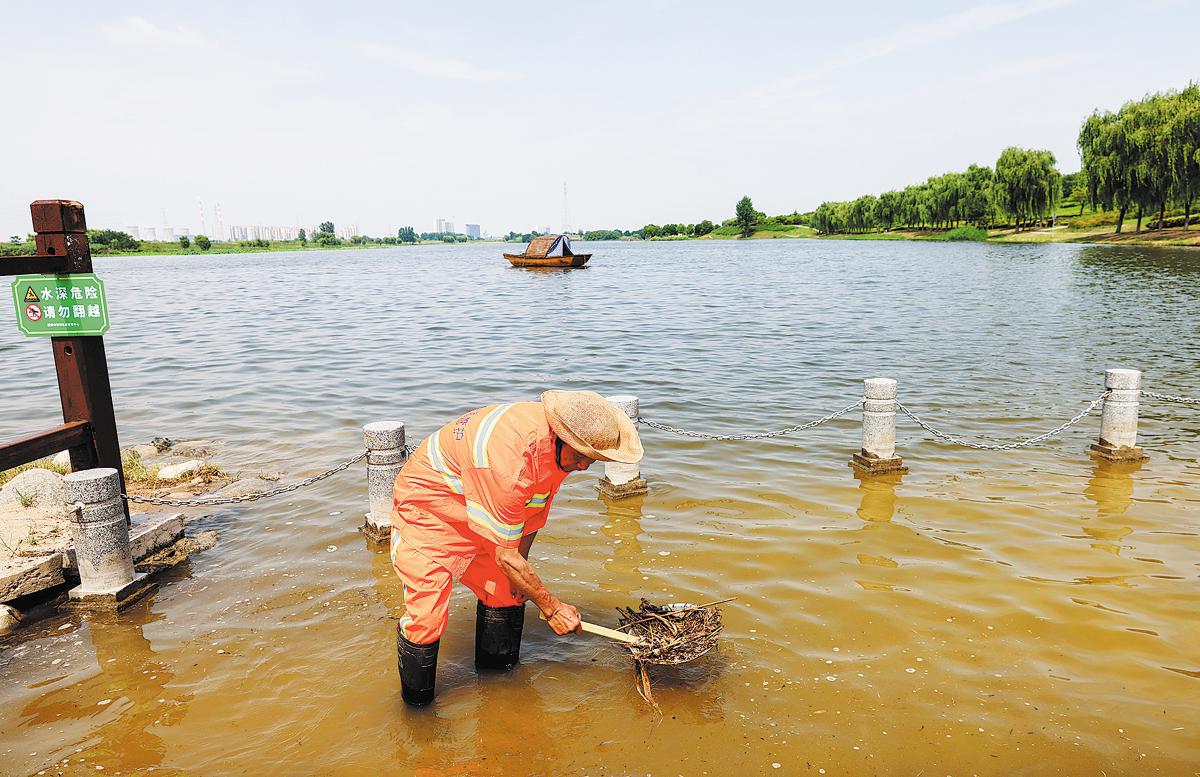source: editor:Zhang Wenni

A sanitation worker cleans tree branches from Xi'an Lake in Xi'an, Shaanxi province, last month. JIA TIANYONG/CHINA NEWS SERVICE
River respite
A 31-km section of the Shichuan River that runs through urban Fuping county is another example of how reclaimed water can be used to improve water bodies for the benefit of both the environment and the people.
The once murky stretch of the 137-km river is today a cherished destination for locals and those from afar.
Zhang Xiqiang, deputy head of Fuping's water resources bureau, said the river suffered rapid environmental deterioration following the construction of a reservoir upstream in the 1960s and 70s for agricultural irrigation.
The reservoir meant a sharp decrease in the amount of water that flowed into Fuping via the watercourse, he said. Sand and stone exploitation, waste dumping and sewage discharge made the situation even worse.
"While the water was heavily polluted, the river often ran dry," he said.
For Zhang Lina, a native of Fuping, the river has always held a special place for decades.
"When I was young, every time I passed the river I wanted to play in it, though it was only a small muddy stream at that time," the 36-year-old recalled. Zhang said her attachment to the river, despite it being tiny and often murky, reflected how scarce water was at that time.
"Washing hair used to be a luxury, and every drop of water was treasured," she said. "If we rinsed our hair in a basin, the water was not discarded but used again by other family members."
Water per capita in Fuping is only about 196 cubic meters, far below the national average of 2,200 cubic meters.
As an IT worker in Shanghai, where there is no shortage of water, Zhang had envied the abundant water resources and recreational opportunities enjoyed by residents in the metropolis.
She never expected, upon returning to her hometown for a visit five years ago, that the river would have been transformed, surpassing her wildest dreams.
"Once a mere trickle, the river now brims with life," she said, smiling with her 3-year-old son sitting in his stroller.
The transformation of the watercourse was the result of a treatment program the local government launched from 2017 to 2019. The program followed the idea that mountains, rivers, forests, farmlands, lakes and grasslands are a "living community".
Besides making the river capable of withstanding once-in-two-decade floods, over 31 km of the Shichuan's 36-km section in Fuping has been treated, according to local authorities.
Pipe networks were constructed to collect wastewater for treatment and divert rainwater and reclaimed water into the river and its tributary, the Wenquan River. Last year, for example, almost 4.8 million cubic meters of reclaimed water was diverted into the two rivers, according to the Fuping government.
In the urban area of Fuping, a 5.2-km stretch of the Shichuan River has been transformed through an afforestation initiative, resulting in the greening of 700,000 square meters of riverside terrain, now a wetland park.
Zhang frequently visits the park with her son during her short breaks from work in Shanghai. "Strolling in such a pleasant environment uplifts my mood," she said.
houliqiang@chinadaily.com.cn